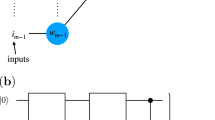Abstract
While quantum architectures are still under development, when available, they will only be able to process quantum data when machine learning algorithms can only process numerical data. Therefore, in the issues of classification or regression, it is necessary to simulate and study quantum systems that will transfer the numerical input data to a quantum form and enable quantum computers to use the available methods of machine learning. This material includes the results of experiments on training and performance of a hybrid quantum-classical neural network developed for the problem of classification of handwritten digits from the MNIST data set. The comparative results of two models: classical and quantum neural networks of a similar number of training parameters, indicate that the quantum network, although its simulation is time-consuming, overcomes the classical network (it has better convergence and achieves higher training and testing accuracy).
Access this chapter
Tax calculation will be finalised at checkout
Purchases are for personal use only
Similar content being viewed by others
References
Abadi, M., Agarwal, A., Barham, P., et al.: TensorFlow: large-scale machine learning on heterogeneous systems (2015). https://www.tensorflow.org/
Broughton, M., et al.: Tensorflow quantum: A software framework for quantum machine learning. arXiv:2003.02989 (2020)
Cirq Developers, Cirq, Zenodo (2020). https://doi.org/10.5281/zenodo.4064322
Deutsch, D.E.: Quantum theory, the Church-Turing principle and the universal quantum computer. Proc. R. Soc. London. A. Math. Phys. Sci. 400(1818), 97–117 (1985). https://doi.org/10.1098/rspa.1985.0070
Deutsch, D.E., Barenco, A., Ekert, A.: Universality in quantum computation. Proc. R. Soc. London. Ser. A Math. Phys. Sci. 449(1937), 669–677 (1995). https://doi.org/10.1098/rspa.1995.0065
Farhi, E., Neven, H.: Classification with quantum neural networks on near term processors. arXiv:1802.06002 (2018)
Fujisawa, T., Hayashi, T., Jung, S.W., Jeong, Y.H., Hirayama, Y.: Single-electron charge qubit in a double quantum dot. In: Ruggiero, B., Delsing, P., Granata, C., Pashkin, Y., Silvestrini, P. (eds.) Quantum Computing in Solid State Systems. Springer, New York, NY (2006). https://doi.org/10.1007/0-387-31143-2_34
Gupta, S., Zia, R.: Quantum neural networks. J. Comput. Syst. Sci. 63(3), 355–383 (2001). https://doi.org/10.1006/jcss.2001.1769
Josephson, B.D.: The discovery of tunnelling supercurrents. Proc. IEEE 62(6), 838–841 (1974). https://doi.org/10.1109/PROC.1974.9524
Le, P.Q., Dong, F., Hirota, K.: A flexible representation of quantum images for polynomial preparation, image compression, and processing operations. Quantum Inf. Process. 10(1), 63–84 (2011). https://doi.org/10.1007/s11128-010-0177-y
LeCun, Y., Cortes, C., Burges, C.: The MNIST database of handwritten digits. Courant Institute, NYU, Google Labs, New York, Microsoft Research, Redmond (2010). http://yann.lecun.com/exdb/mnist/
Lucatto, B., Koda, D.S., Bechstedt, F., Marques, M., Teles, L.K.: Charge qubit in van der Waals heterostructures. Phys. Rev. B 100(12), 121406 (2019). https://doi.org/10.1103/PhysRevB.100.121406
Morton, J.J., et al.: Solid-state quantum memory using the \(^{31}\)P nuclear spin. Nature 455(7216), 1085–1088 (2008). https://doi.org/10.1038/nature07295
Mosakowski, J., Owen, E., Ferrus, T., Williams, D., Dean, M., Barnes, C.: An optimal single-electron charge qubit for solid-state double quantum dots. arXiv:1603.05112 (2016)
Nielsen, M.A., Chuang, I.: Quantum Computation and Quantum Information. Cambridge University Press, Cambridge (2000). https://doi.org/10.1017/CBO9780511976667
Pla, J.J., et al.: A single-atom electron spin qubit in silicon. Nature 489(7417), 541–545 (2012). https://doi.org/10.1038/nature11449
Potempa, R.: Simulation of quantum neural network with evaluation of its performance. Silesian University of Technology, Gliwice, Poland (2021)
Preskill, J.: Quantum computing in the NISQ era and beyond. Quantum 2, 79 (2018). https://doi.org/10.22331/q-2018-08-06-79
Riedl, S., Lettner, M., Vo, C., Baur, S., Rempe, G., Dürr, S.: Bose-Einstein condensate as a quantum memory for a photonic polarization qubit. Phys. Rev. A 85(2), 022318 (2012). https://doi.org/10.1103/PhysRevA.85.022318
Zhou, Z.-Q., Lin, W.-B., Yang, M., Li, C.-F., Guo, G.-C.: Realization of reliable solid state quantum memory for photonic polarization qubit. Phys. Rev. Lett. 108(19), 190505 (2012). https://doi.org/10.1103/PhysRevLett.108.190505
Acknowledgements
The authors would like to thank the referees for their comments that helped to improve the presentation of this paper. This research is financed from the statutory activities of the Faculty of Automatic Control, Electronics and Computer Science of the Silesian University of Technology.
Author information
Authors and Affiliations
Corresponding author
Editor information
Editors and Affiliations
Rights and permissions
Copyright information
© 2022 The Author(s), under exclusive license to Springer Nature Switzerland AG
About this paper
Cite this paper
Potempa, R., Porebski, S. (2022). Comparing Concepts of Quantum and Classical Neural Network Models for Image Classification Task. In: Choraś, M., Choraś, R.S., Kurzyński, M., Trajdos, P., Pejaś, J., Hyla, T. (eds) Progress in Image Processing, Pattern Recognition and Communication Systems. CORES IP&C ACS 2021 2021 2021. Lecture Notes in Networks and Systems, vol 255. Springer, Cham. https://doi.org/10.1007/978-3-030-81523-3_6
Download citation
DOI: https://doi.org/10.1007/978-3-030-81523-3_6
Published:
Publisher Name: Springer, Cham
Print ISBN: 978-3-030-81522-6
Online ISBN: 978-3-030-81523-3
eBook Packages: Intelligent Technologies and RoboticsIntelligent Technologies and Robotics (R0)




